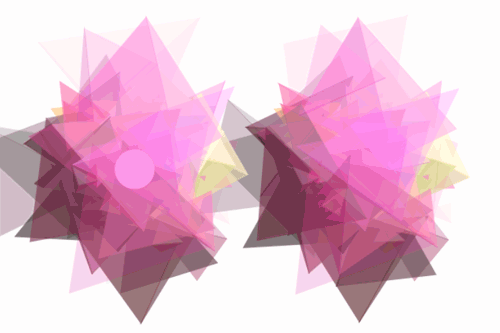Events and Parties
Will Galleries and Museums Ever Embrace Animated GIF Art?
The beloved Internet image format is still looking for art world acceptance.

The beloved Internet image format is still looking for art world acceptance.

Paddy Johnson

The year 2012 was a momentous one for the animated GIF. The popularity of Dump.fm was just beginning to fade, but the platform, which facilitates real-time chat with images, had sparked GIF-making among countless creatives, from programmers and musicians to designers and visual artists. With the rise of Tumblr, and the launch of Google+—social networks used extensively by artists to connect with each other and share GIFs—the medium became so ubiquitous that it was even dubbed the “Word of the Year” by the Oxford Dictionary.
Two years on, has the mass popularity of GIFs affected art GIF-making communities? Rich Oglesby, who runs the Tumblr blog Prosthetic Knowledge, reminded me that GIFs have been present in online culture since the early days of the web, long before the rise of the GIF industry—Giphy, Gifpop!, Giphoscope, NewHive, etc. Back then sites like Word, Geocities, and B3ta were hosting familiar GIF archetypes that remain today: animated illustrations, stop-motion, glitchy discolorations, and digital low-res vectors. “And let’s not forget the glitter-vomit of MySpace pages,” Oglesby recalled.
Since that time, GIFs have become increasingly visible, in commercial as well as non-commercial settings. There is a long history of GIF sales, but more recently, in 2011, Rhizome sold a selection of animated GIFs at the Armory Art Show; and, in 2012, Klausgallery.net offered a GIF by Nicolas Sassoon. Just this year TRANSFER has opened a store that sells, among other things, limited edition lenticular prints made by artists.
It’s this history of relatively widespread accessibility that informs the artists making art GIFs. Artist Tom Moody, an early adopter, described what makes the art GIF distinct. “It’s a matter of context,” he said. “You have to catch the movement of images—the reacting or punning flow of one into another as people respond to each other’s posts. If it’s a ‘surf club’-type situation, if it’s happening on Tumblr or Dump.fm… to me that can be very much in the art domain, like a performance, whether the individual GIFs are self-consciously ‘art’ or not. That’s not the only ‘art’ use of GIFs, just one of the more subtle and difficult to identify (and document).” Another GIF-maker and artist, Anthony Antonellis, preferred to describe successful GIFs as silent “melodies”. They can take on as many different shapes as a song has stanzas.
Moody, like most GIF-makers I spoke to, cited the ease of loading the file format in a browser as a large part of its appeal. The recent rise of platforms friendly to the medium has also made a big difference. “Social media opened [the field] up,” curator, artist, and GIF-maker Lorna Mills told me over the phone. Mills highlighted her co-organization of Sheroes with Rea McNamara as an energizing force within the community; that project was a series of monthly, limited-run art parties that ran from 2011 to 2012 and asked artists to make GIFs and other works responding to “legendary ladies.” Dolly Parton, Grace Jones, and Yoko Ono were each honored with projection-backed performances and installations, and the event, which began with only a couple of artists, quickly grew to include over 45 participants. “We were one of the first to do events where GIFs were central, and we were doing it with large groups of people,” Mills said. “The community grew, and with it going offline, the file size [of the GIF] wasn’t issue. People could get quite extravagant.”
Sheroes has become just one example of a growing number of events that bring out audiences. Now, similar offline parties are everywhere: Antonellis and Mills co-organized “When Analogue Became Digital” in Berlin; there was “DUMP.FM IRL” at 319 Scholes; every closing reception at TRANSFER gallery; the David Bowie GIF opening for the Art Gallery of Ontario; and the projection fundraiser “Liquidation,” which was organized by Jennifer Chan. Even online events such as The Wrong Biennale seem to bring in repeat visitors and spark new work. The Biennial’s still in its first iteration (and closed, so the site is down for the next two years), but the energy and enthusiasm of participants and friends stands in contrast to many of the art world’s online, time-based ventures, which seem to quickly fizzle out—the short-lived VIP Fair being the most notable example.
Sometimes it wasn’t the events or available platforms that got people involved in making GIF artworks, but the image format’s limitations. Like many artists I spoke with, San Francisco-based artist Andrew Benson started making GIFs mostly as a means of enticing Tumblr users to click on his videos. “I really thought of animated GIFs as being like the underwear drawer of my artistic career,” he said. “It’s a bunch of stuff I was sort of doing on my own, but it turned out there was an audience for it.” For Benson, the aesthetic appeal of GIFs is closely tied to their accessibility: “The lowbrow quality of animated GIFs opens up the opportunity to do something off-the-cuff and experimental.”

From Nicolas Sassoon’s Homeland Studies series (2012).
Courtesy the artist, via Lorna Mills.
And while people have theorized, criticized, and categorized GIFs to no end, they remain in a kind of browser-based Neverland that is unfamiliar to many of those in the art establishment. A. Bill Miller, a GIF-maker and art professor based in Wisconsin, told me that he asks students to evaluate GIFs less on concept, and more on the qualities particular to the file format: “How it loops, file size, compression, and color and that sort of stuff.” Mills, for her part, deemed smooth GIFs undesirable because they become “boring” and look too much like video.
Notably, most evaluation criteria assume the distracted viewing experience of a browser, which is also the kind of viewer you’re going to get at the offline parties and GIF events mentioned above. Nobody wants to quietly contemplate art at a party. According to McNamara, these events have only received a kind of half-acceptance from the museum world. “GIF-focused events come from that DIY exhibition format tradition of Speed Shows, BYOB, etc.,” she said. “But I’ve seen certain open call group shows happen via institutions and the like that are these one-time-only events deemed separate from their broader programming initiatives. They’re treated like stunts.” The Tate’s call to GIF their art collection from the 1800s smacks of the kind of marketing strategy that seeks to exploit a pre-existing interest for quick attention.
This speaks to the persistent problem of GIFs’ validation within the art world. As McNamara noted, for all the listicles of GIF artists you need to know, there seems to be precious little by way of historicizing or critical discussion. “That’s really where we decide whether its a viable creative medium,” Moody said, lamenting the replacement of discourse with “GIF of the Day” posts (a series we run on Art F City).
There’s some question as to whether GIF-makers benefit from this validation, and many without art backgrounds tend not to seek it. In some ways, their situation is similar to those of comics artists, who have never been embraced by the art market. Do these fields benefit from the art world’s relative indifference? For those GIF-makers who have professional arts degrees, the desire to evaluate the art GIF in art terms can create tension.
“I feel like there’s not a good way to view [GIFs] in the gallery setting,” Benson told me. “They really belong on your browser.” And the problem with a web browser, according to Benson, is that it’s “a pretty terrible art viewing context.” The physicality of an object in a gallery commands attention in a way that the online artwork does not. “Because [the browser] is a general, all-purpose context, it doesn’t feel special,” Benson added. “It’s kind of like when I see art in a coffee shop; I’m there to drink coffee and do work. I’m not there to study the art.”
This anecdote highlights the challenge of even describing the medium, a problem Chan articulated in an email. “The GIF finds difficulty in occupying a genre and even resists many categorizations (it’s not photography or video, and there isn’t something else you can apply dither to and load in browser),” she wrote. “If there are inherent properties to GIFs like we mentioned (movement, jerkiness, short messages, repetition), maybe people can’t assess them with the same contemplative lens they bring to the fine arts.”
And while that mentality seems very much behind the rise of the art GIF party, sustained growth at the level seen in 2012 seems almost impossible. The Dump.fm community has shrunk over the years, and nobody I spoke to uses Google+ anymore. “I really do think of that first summer with Google+ as a beautiful era for GIFs,” Antonellis recalled. “It did something more than Dump.fm could,” he said, referring to the extended time users had to respond to posts. Google+ acted more like a blog than Dump’s chat room.
Conversations like these reveal just how much GIFs live or die by these platforms. “We’ve come to rely on these consumer-grade solutions because that’s what’s available, but it was never the intention of the makers. It was never the intention of Google+ to be the platform for sharing animated GIFs,” Benson said. “It feels like the community has contracted a certain amount in the last year. Maybe it’s just the fossilization of my own social network, but I’m not seeing these big expansive GIF group shows.” A. Bill Miller, by contrast, is a little more optimistic in his assessment. “It feels like [the community is] always growing and contracting.” he tells me. “It’s in a middle stage.”